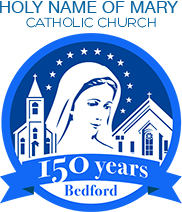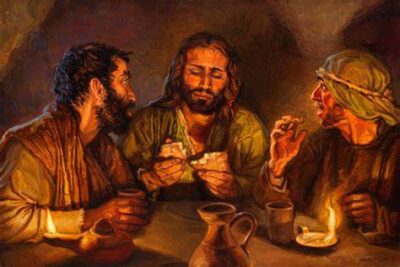Third Sunday of Easter
April 23, 2023 — Year A
Readings: Acts 2:14, 22-33 / Ps 16 / 1 Pt 1:17-21 / Lk 24:13-35
by Rev. Mr. Mark De La Hunt, Permanent Deacon
[Parish children received their first Eucharist today. The first part of the homily is directed toward them.]
The Eucharist makes us like Jesus, who said, “I am the light of the world (Jn 8:12).” Therefore, when you receive Holy Communion, you become a light in the world. This is why St. Paul wrote that you are meant to “shine like stars in the world (Phil 2:15).” So, it is right that you all decorated candles and put them on the windowsills. Candles are a sign of Jesus, our light. There are candles by the ambo to signify Jesus, the light as the Word of God, and by the altar, Jesus, the light as the body and blood of God. Jesus wants us to be a light in the world. How?
Jesus told us how. He said, “Love one another as I have loved you (Jn 13:34).” So be kind to everyone, especially those that others are mean to or make fun of or ignore. Be loving to everyone in your home. Obey your parents; remember that Jesus was made perfect in His obedience (Heb 5:8-10). Spend time with Grandma and Grandpa; you are their joy, and the time you spend with them is a great treasure for them. Ask them to tell you stories from their life and you will learn much. Pray; God loves it when you talk with Him. He becomes a good friend when you spend time talking to Him every day. And by the way, if someone tells you the bread is only a symbol, you say: “That is heresy (Fr. Dan Beamon homily).”
[Rest of Homily]
As the youth are receiving First Holy Communion in our two parishes this weekend, I thought it would be a good time to talk about the mechanics of receiving. Please do not think I am judging your technique when you come forward. What I want to do is reduce the number of times Jesus’ precious body falls to the floor and to remove some of the anxiousness of the priest, deacon, and extraordinary Eucharistic ministers. Here is a refresher.
- Wash your hands before Mass.
- Walk up reverently. You are approaching your Savior and King.
- While the person in front of you is receiving, bow reverently.
- If receiving by hand:
- Put your hands in the shape of an X-cross making one hand a throne for the Holy Sacrament.
- If you are right-handed, make the left hand the throne and vice-versa if you are left-handed.
- Place your hands at chest height.
- After the minister says, “the Body of Christ,” you say out loud, “Amen.” Speak louder than normal if wearing a mask, as we cannot see your lips moving.
- After Jesus is placed in your hand, step to the side, stop, and reverently place our Lord in your mouth before walking back to your seat.
- If you only have one hand available, you should receive on the tongue.
- If receiving on the tongue, be sure to open your mouth and extend your tongue beyond your lips.
Now let’s open up God’s word a bit. Have you ever wondered what Jesus told the two disciples on the road to Emmaus? Oh, to have been there and hear Jesus, the Word made flesh, teach scripture! In the gospel Luke wrote, “Then beginning with Moses and all the prophets, [Jesus] interpreted to them what referred to Him in all the scriptures (Lk 24:27).” Fr. Pablo Gadenz, in his commentary of the Gospel of Luke, suggests that we could be hearing what Jesus taught them when we read what is said by His followers in the Book of Acts (395).
We just heard an example of that in the first reading from Acts. Peter interprets to them what referred to Jesus in the scriptures. Peter said, “For David says of [Jesus]: I saw the Lord before me…My flesh, too, will dwell in hope, because You will not abandon my soul to the netherworld (Acts 2: 25-27).” He was quoting King David’s Psalm 16, which we sang a few minutes ago.
I think Fr. Gadenz is on to something here, and it is exciting. It makes me want to read Acts again with the mindset that when Peter and Stephen speak, they are sharing what Jesus taught on the road to Emmaus! (By the way, the Hallow app has a daily podcast for the Easter season where Jonathan Roumie reads one chapter from Acts each day and Dr. Scott Hahn explains it.)
In this Road-to-Emmaus gospel passage, there is another important point. Jesus explains the scriptures and then He blesses and breaks the bread. This is what we do at every Mass. Why did Jesus not simply get straight to the Eucharist and then talk about scripture? Was the order important or simply coincidental?
In Bishop Barron’s Word on Fire Bible, he points out, as does Fr. Gadenz, it is the “divine purpose” to use scripture to gradually prepare our hearts and minds and to stir up our faith, but it is not until we see the Eucharist that we truly see Christ (Barron 445). This makes sense. Those two disciples were sad and agitated and downcast. Once they heard the Word of God and heard it explained, their hearts were “burning within them (Lk 24:32).” Then their “eyes were opened” and they were ready to see Jesus in the breaking of the bread (Lk 24: 31).
This is why it is so important to get our families to Mass. A mountain hike, a walk at sunset on the lake shore, holding hands with that special someone on the porch, gazing at the moon on a starry night, etc., reveal God to us Who is in all things, but ONLY at Mass do we hear Him clearly in the Word and see Him clearly in the Eucharist.
Bishop Barron says of Jesus in the Eucharist that He is “breaking his heart open in compassion.” What images does this bring to your mind? One is the priest breaking the consecrated bread and placing a piece in the chalice of blood and water. This is evocative of the blood and water that poured forth from His side on the cross, which is the like the image we celebrated last week on Divine Mercy Sunday with red and blue rays coming from His heart. And then I think of the Eucharistic miracles posted in the hallway of Holy Name of Mary, where the Eucharist became flesh. Scientists who were asked to analyze the tissue, without knowing where it came from, said that the tissue is that of a heart. Do you see a recurring image here? It is the image of Jesus’ Sacred Heart.
No one knew Jesus’ heart more intimately than his mother, Mary. St. Pope John Paul II wrote about this, “And is not the enraptured gaze of Mary as she contemplated the face of the newborn Christ and cradled Him in her arms that unparalleled model of love which should inspire us every time we receive Eucharistic communion (Ecclesia de Eucharistia)?” John Paul is describing the Third Joyful Mystery of the Holy Rosary, the Nativity, and is tying it to the Fifth Luminous Mystery, that he gave us, which is the Institution of the Eucharist. Imagine Mary looking at her Son’s heart in her hand at her first Holy Communion and her mind flashing back to holding Him in her arms at Bethlehem.
Mary, pray for us that every time we receive your Son in Holy Communion, we will see Him with your eyes and love Him with your Immaculate Heart. Amen.
Citations
Peter Kreeft. Food for the Soul – Reflections on the Mass Readings for Cycle A. Word of Fire 2022.
Bishop Robert Barron. The Word on Fire Bible_The Gospels. Word on Fire Ministries 2020.
Fr. Pablo T. Gadenz. Catholic Commentary of Sacred Scripture. The Gospel of Luke. Baker Academic, 2018.
Katie Yoder. 15 Quotes from St. John Paul II on his love for the Eucharist. Catholic News Agency (CNA) Oct 22, 2022.
 540-586-8988
540-586-8988 

